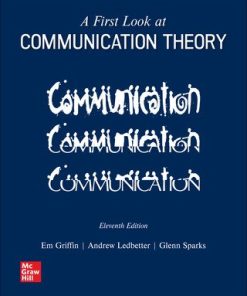Introducing Communication Theory Analysis and Application 7th Edition by Richard West, Lynn Turner 1260254097 978-1260254099
$50.00 Original price was: $50.00.$25.00Current price is: $25.00.
Introducing Communication Theory: Analysis and Application 7th Edition by Richard West, Lynn H. Turner – Ebook PDF Instant Download/DeliveryISBN: 1260254097, 978-1260254099
Full download Introducing Communication Theory: Analysis and Application 7th Edition after payment.

Product details:
ISBN-10 : 1260254097
ISBN-13 : 978-1260254099
Author : Richard West, Lynn H. Turner
Introducing Communication Theory: Analysis and Application focuses on the links between theory and everyday experiences. This text uses an engaging writing style and a consistent, organized template to present the concept of theory and help students become insightful, critical thinkers. The Connect course for this offering includes SmartBook, an adaptive reading and study experience that guides students to master, recall, and apply key concepts while providing automatically graded assessments.
Introducing Communication Theory: Analysis and Application 7th Table of contents:
Chapter 1: Thinking About Communication: Definitions, Models, and Ethics
Chapter 1 Introduction
Defining Communication
Models of Understanding: Communication as Action, Interaction, and Transaction
Communication as Action: The Linear Model
Communication as Interaction: The Interactional Model
Communication as Transaction: The Transactional Model
Communication Models of the Future
Ethics and Communication
Business and Industry
Religion and Faith
Entertainment
Higher Education
Medicine
Politics
Technology
Some Final Thoughts
The Value of Understanding Communication Theory
Understanding Communication Theory Cultivates Critical Thinking Skills
Understanding Communication Theory Helps You to Recognize the Breadth and Depth of Research
Understanding Communication Theory Helps You to Make Sense of Personal Life Experiences
Communication Theory Fosters Self-Awareness
Conclusion
Discussion Starters
Key Terms
References
Chapter 2: Thinking About the Field: Traditions and Contexts
Chapter 2 Introduction
A Historical Briefing
Seven Traditions in the Communication Field
The Rhetorical Tradition: Communication and the Art of Public Speaking
The Semiotic Tradition: Communication and the Co-Creation of Signs
The Phenomenological Tradition: Communication and the Analysis of the Everyday
The Cybernetic Tradition: Communication and the Processing of Information via Feedback
The Socio-Psychological Tradition: Communication and the Science of Human Behavior
The Socio-Cultural Tradition: Communication and Socially Constructed Reality
The Critical Tradition: Communication and Questioning the Status Quo
Putting It All Together
Seven Contexts in the Communication Field
Intrapersonal Communication
Interpersonal Communication
Small Group/Team Communication
Organizational Communication
Public/Rhetorical Communication
Mass/Media Communication
Cultural Communication
Collating the Contexts
Conclusion
Discussion Starters
Key Terms
References
Chapter 3: Thinking About Theory and Research
Chapter 3 Introduction
Defining Theory: What’s in a Name?
Components of Theories
Goals of Theories
Approaches to Knowing: How Do You See (and Talk About) the World?
The Positivistic, or Empirical, Approach
The Interpretive Approach
The Critical Approach
Approaches to Knowing: What Questions Do You Ask About the World?
Approaches to Knowing: How Do We Go About Theory Building?
Covering Law Meta-Theory
Rules Meta-Theory
Systems Meta-Theory
Evaluating Theory: Determining Theory Effectiveness
Theory and Metaphor
The Research Process
Objective (Quantitative) Communication Research
Subjective (Qualitative) Communication Research
Conclusion
Discussion Starters
Key Terms
References
Organization of “Introducing Communication Theory: Analysis and Application”
Organization of “Introducing Communication Theory: Analysis and Application”
Empirical/Post-Positivist Theories
Interpretive Theories
Critical Theories
Chapter 4: Expectancy Violations Theory
Chapter 4 Introduction
Space Relations
Proxemic Zones
Territoriality
Assumptions of Expectancy Violations Theory
Arousal
Threat Threshold
Violation Valence
Communicator Reward Valence
Integration and Critique
Integration
Critique
Closing
Discussion Starters
Key Terms
References
Chapter 5: Uncertainty Reduction Theory
Chapter 5 Introduction
Assumptions of Uncertainty Reduction Theory
Key Concepts of Uncertainty Reduction Theory: The Axioms and Theorems
Axioms of Uncertainty Reduction Theory
Theorems of Uncertainty Reduction Theory
Expansions of Uncertainty Reduction Theory
Antecedent Conditions
Strategies
Developed Relationships
Social Media and Computer-Mediated Communication
Context
Integration and Critique
Integration
Critique
Closing
Discussion Starters
Key Terms
References
Chapter 6: Social Exchange Theory
Chapter 6 Introduction
Assumptions of Social Exchange Theory
Dimensions of Interdependence
Evaluation of a Relationship
Power and Exchange Patterns
Integration and Critique
Integration
Critique
Closing
Discussion Starters
Key Terms
References
Chapter 7: Social Penetration Theory
Chapter 7 Introduction
Assumptions of Social Penetration Theory
“Tearing Up” the Relationship: The Onion Analogy
A Social Exchange: Relational Costs and Rewards
Stages of the Social Penetration Process
Orientation: Revealing Bit by Bit
Exploratory Affective Exchange: The Self Emerges
Affective Exchange: Commitment and Comfortability
Stable Exchange: Raw Honesty and Intimacy
Integration and Critique
Integration
Critique
Closing
Discussion Starters
Key Terms
References
Chapter 8: Social Information Processing Theory
Chapter 8 Introduction
Theoretical Turbulence: The Cues Filtered Out
Assumptions of Social Information Processing Theory
Hyperpersonal Perspective: “I Like What I Read and I Want More”
Sender: Selective Self-Presentation
Receiver: Idealization of the Sender
Channel Management
Feedback
Warranting: Gaining Confidence Online
Integration and Critique
Integration
Critique
Closing
Discussion Starters
Key Terms
References
Chapter 9: Structuration Theory
Chapter 9 Introduction
Assumptions of Structuration Theory
Central Concepts of Structuration Theory
Agency and Reflexivity
Duality of Structure
Social Integration
Application of Time and Space
Integration and Critique
Integration
Critique
Closing
Discussion Starters
Key Terms
References
Chapter 10: Organizational Information Theory
Chapter 10 Introduction
The Only Constant Is Change (in Organizations)
General Systems Theory
Darwin’s Theory of Sociocultural Evolution
Assumptions of Organizational Information Theory
Key Concepts and Conceptualizing Information
Information Environment: The Sum Total
Rules: Guidelines to Analyze
Self-Governance in an Age of Rules
Cycles: Act, Respond, Adjust
The Principles Related to Equivocality
Reducing Equivocality: Trying to Use the Information
Enactment: Assigning Message Importance
Selection: Interpreting the Inputs
Retention: Remembering the Small Stuff
Integration and Critique
Integration
Critique
Closing
Discussion Starters
Key Terms
References
Chapter 11: Agenda Setting Theory
Chapter 11 Introduction
History of Agenda Setting Research
Pretheoretical Conceptualizing
Establishing the Theory
Elaborating the Theory
Assumptions of Agenda Setting Theory
Three-Part Process of Agenda Setting
Three Levels of Agenda Setting
Integration and Critique
Integration
Critique
Closing
Discussion Starters
Key Terms
References
Chapter 12: Spiral of Silence Theory
Chapter 12 Introduction
The Court of Public Opinion
Assumptions of Spiral of Silence Theory
The Media’s Influence
The Train Test
The Hard Core
Speaking Out About Various Issues
The Spiral of Silence and Social Media
Integration and Critique
Integration
Critique
Closing
Discussion Starters
Key Terms
References
Chapter 13: Uses and Gratifications Theory
Chapter 13 Introduction
Assumptions of Uses and Gratifications Theory
History of Uses and Gratifications Research
Changing Positions on Media Effects
Key Concepts
Contemporary Applications of Uses and Gratifications Theory
Integration and Critique
Integration
Critique
Closing
Discussion Starters
Key Terms
References
Chapter 14: Face-Negotiation Theory
Chapter 14 Introduction
About Face
Face and Politeness Theory
Facework
Assumptions of Face-Negotiation Theory
Individualistic and Collectivistic Cultures
Face Management and Culture
Managing Conflict Across Cultures
Integration and Critique
Integration
Critique
Closing
Discussion Starters
Key Terms
References
Chapter 15: Symbolic Interaction Theory
Chapter 15 Introduction
History of Symbolic Interaction Theory
Assumptions of Symbolic Interaction Theory
Individuals Construct Meaning via the Communication Process
Self-Concept Is a Motivation for Behavior
A Unique Relationship Exists Between the Individual and Society
Key Concepts
Mind
Self
Society
Integration and Critique
Integration
Critique
Closing
Discussion Starters
Key Terms
References
Chapter 16: Coordinated Management of Meaning
Chapter 16 Introduction
All the World’s a Stage
Assumptions of Coordinated Management of Meaning
The Hierarchy of Organized Meaning
Content
Speech Act
Episodes
Relationship
Life Scripts
Cultural Patterns
Charmed and Strange Loops
The Coordination of Meaning: Making Sense of the Sequence
Influences on the Coordination Process
Rules and Unwanted Repetitive Patterns
Integration and Critique
Integration
Critique
Closing
Discussion Starters
Key Terms
References
Chapter 17: Communication Privacy Management Theory
Chapter 17 Introduction
Assumptions of Communication Privacy Management
Evolution of Communication Privacy Management Theory
Key Concepts, Components, and Axioms of CPM
Component 1: Privacy Ownership
Component 2: Privacy Control
Component 3: Privacy Turbulence
Integration and Critique
Integration
Critique
Closing
Discussion Starters
Key Terms
References
Chapter 18: Groupthink
Chapter 18 Introduction
Assumptions of Groupthink
What Comes Before: Antecedent Conditions of Groupthink
Group Cohesiveness
Structural Factors
Group Stress
Symptoms of Groupthink
Overestimation of the Group
Closed-Mindedness
Pressures Toward Uniformity
Think Before You Act: Ways to Prevent Groupthink
Polythink: Moving Beyond the Groupthink Phenomenon
Integration and Critique
Integration
Critique
Closing
Discussion Starters
Key Terms
References
Chapter 19: Organizational Culture Theory
Chapter 19 Introduction
The Cultural Metaphor: Of Spider Webs and Organizations
Assumptions of Organizational Cultural Theory
Ethnographic Understanding: Laying It On Thick
The Communicative Performance
Ritual Performances
Passion Performances
Social Performances
Political Performances
Enculturation Performances
Integration and Critique
Integration
Critique
Closing
Discussion Starters
Key Terms
References
Chapter 20: The Rhetoric
Chapter 20 Introduction
The Rhetorical Tradition
Assumptions of the Rhetoric
The Syllogism: A Three-Tiered Argument
Canons of Rhetoric
Invention
Arrangement
Style
Delivery
Memory
Types of Rhetoric
Integration and Critique
Integration
Critique
Closing
Discussion Starters
Key Terms
References
Chapter 21: Dramatism
Chapter 21 Introduction
Assumptions of Dramatism
Dramatism as New Rhetoric
Substance and Identification/Division
The Process of Guilt and Redemption
The Pentad
Integration and Critique
Integration
Critique
Closing
Discussion Starters
Key Terms
References
Chapter 22: The Narrative Paradigm
Chapter 22 Introduction
Assumptions of the Narrative Paradigm
Key Concepts in the Narrative Approach
Narration (or Narratives)
Narrative Rationality
Integration and Critique
Integration
Critique
Closing
Discussion Starters
Key Terms
References
Chapter 23: Media Ecology Theory
Chapter 23 Introduction
Assumptions of Media Ecology Theory
Making Media History and Making “Sense”
The Tribal Era
The Literate Era
The Print Era
The Electronic Era
The Medium Is the Message
Gauging the Temperature: Hot and Cool Media
The Circle Is Complete: The Tetrad
Enhancement
Obsolescence
Retrieval
Reversal
Carrying the McLuhan Banner: Postman and Meyrowitz
Integration and Critique
Integration
Critique
Closing
Discussion Starters
Key Terms
References
Chapter 24: Communication Accommodation Theory
Chapter 24 Introduction
Social Psychology and Social Identity
Assumptions of Communication Accommodation Theory
Ways to Adapt
Convergence: Merging Thoughts Ahead
Divergence: Vive la différence
Overaccommodation: Miscommunicating with a Purpose
Integration and Critique
Integration
Critique
Closing
Discussion Starters
Key Terms
References
Chapter 25: Relational Dialectics Theory
Chapter 25 Introduction
Assumptions of Relational Dialectics Theory
Central Propositions of Relational Dialectics Theory
Interpretive Research in Relational Dialectics Theory
Basic Dialectic 1: Autonomy and Connection
Basic Dialectic 2: Openness and Protection
Basic Dialectic 3: Novelty and Predictability
Beyond Basic Dialectics
Contextual Dialectics
Responses to Dialectics
Relational Dialectics Theory 2.0: A Critical Turn
Integration and Critique
Integration
Critique
Closing
Discussion Starters
Key Terms
References
Chapter 26: Cultivation Theory
Chapter 26 Introduction
Developing Cultivation Theory
Assumptions of Cultivation Theory
Processes and Products of Cultivation Theory
The Four-Step Process
Mainstreaming and Resonance
The Mean World Index
Cultivation Theory as Critical Theory
Integration and Critique
Integration
Critique
Closing
Discussion Starters
Key Terms
References
Chapter 27: Cultural Studies
Chapter 27 Introduction
The Marxist Legacy: Power to the People
Assumptions of Cultural Studies
Hegemony: The Influence on the Masses
Counter-Hegemony: The Masses Start to Influence the Dominant Forces
Audience Decoding
Integration and Critique
Integration
Critique
Closing
Discussion Starters
Key Terms
References
Chapter 28: Muted Group Theory
Chapter 28 Introduction
History of Muted Group Theory
Dominant and Non-Dominant Groups
Assumptions of Muted Group Theory
The Process of Silencing
Ridicule
Ritual
Control
Harassment
Strategies of Resistance
Integration and Critique
Integration
Critique
Closing
Discussion Starters
Key Terms
References
Chapter 29: Feminist Standpoint Theory
Chapter 29 Introduction
Evolution of Feminist Standpoint Theory
Standpoint Theory
Feminist Standpoint Theory
Black Feminist Standpoint Theory
Feminist Standpoint Theory and Black Feminist Standpoint Theory in Communication Studies
Assumptions of Feminist Standpoint Theory
Key Concepts of Feminist Standpoint Theory
Voice
Standpoint
Situated Knowledges
Sexual Division of Labor
Integration and Critique
Integration
Critique
Closing
Discussion Starters
Key Terms
References
Chapter 30: Co-Cultural Theory
Chapter 30 Introduction
Foundations of Co-Cultural Theory
Muted Group Theory
Standpoint Theory
Phenomenology
Assumptions of Co-Cultural Theory
Communication Orientations and Strategies
Goals/Preferred Outcomes
Approaches
Communication Orientations
Testing the Communication Orientations
Strategies
Other Factors Influencing NDGMs’ Communication Choices
Field of Experience
Perceived Costs and Rewards
Capability
Situation
Integration and Critique
Integration
Critique
Closing
Discussion Starters
Key Terms
References
Afterword
Afterword ← ConnectingQuests
Appendix: Theory Summaries
Appendix
Agenda Setting Theory
Co-Cultural Theory
Communication Accommodation Theory
Communication Privacy Management Theory
Coordinated Management of Meaning (CMM)
Cultural Studies
Cultivation Theory
Dramatism
Expectancy Violations Theory
Face-Negotiation Theory
Feminist Standpoint Theory
Groupthink
Media Ecology Theory
Muted Group Theory
The Narrative Paradigm
Organizational Culture Theory
Organizational Information Theory
Relational Dialectics Theory
The Rhetoric
Social Exchange Theory
Social Penetration Theory
Social Information Processing Theory
Spiral of Silence Theory
Structuration Theory
Symbolic Interaction Theory
Uncertainty Reduction Theory
Uses and Gratifications Theory
People also search for Introducing Communication Theory: Analysis and Application 7th:
borrow introducing communication theory analysis and application
introducing communication theory analysis and application pdf
introducing communication theory analysis and application 7th edition
introducing communication theory analysis and application (6th edition pdf)
introducing communication theory analysis and application 7th ed
Tags: Introducing Communication, Theory, Analysis, Application, Richard West, Lynn Turner
You may also like…
Engineering - Mechanical Engineering & Dynamics
Theory and Design for Mechanical Measurements 7th Edition Richard S. Figliola
Engineering - Electrical & Electronic Engineering
Fundamentals of Electric Circuits 7th (International Student Edition) Charles K. Alexander
Business & Economics - Accounting
International Accounting 6th Edition by Timothy Doupnik 1266386275 9781266386275
Engineering - Electrical & Electronic Engineering
Technique - Electronics: Microprocessor Technology
Uncategorized
Business & Economics - Management & Leadership
Organization Theory & Design: An International Perspective 4th Edition Richard L. Daft
Chemistry - Chemistry - General & Miscellaneous
(EBook PDF) Chemistry 6th Edition by Julia Burdge 1264507798 9781264507795 full chapters












